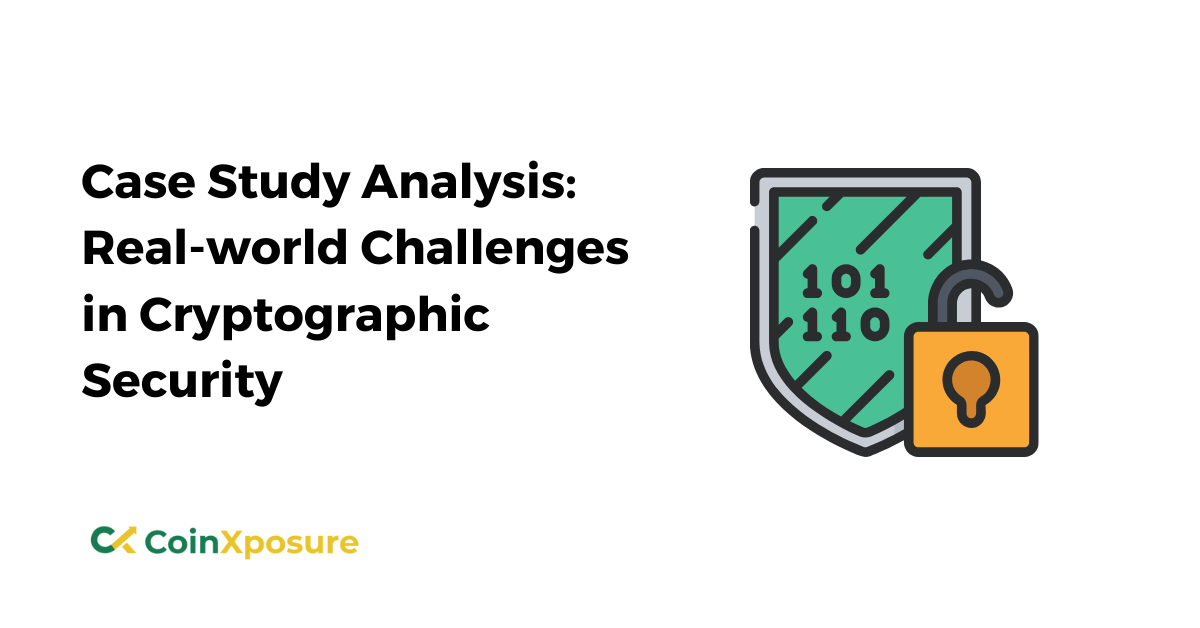
Cryptographic security is vital as it protects data from third-party infiltrations. As crucial as it is to organizations, cryptography is faced with some challenges that minimize its efficiency.
In this article, we will discuss some real-world challenges in cryptographic security.
Before we go all out, let’s get the basics straight.
What is Cryptographic Security?
Cryptographic security entails keeping communications secure from outside observers. Encryption techniques turn the original message, or plaintext, into ciphertext, which needs to be comprehensible.
The decryption key enables the user to decrypt the communication, ensuring they can read it. The strength of an encryption’s unpredictability is also investigated, making it more difficult for anyone to guess the key or algorithmic input.
Cryptographic security is how we can create more secure and strong connections that protect our privacy.
Advances in cryptographic security make it more challenging to break encryptions, limiting access to encrypted data, folders, or network connections to authorized users.
Now that we know what cryptographic security is, what makes it unique and almost indispensable?
Why is Cryptographic Security So Important?
A secure system should provide various assurances, including data confidentiality, integrity, availability, authentication, and non-repudiation.
Cryptographic security, when applied effectively, can assist give these assurances. Cryptographic security can protect the privacy and integrity of data in transit and at rest.
It can also authenticate senders and recipients while protecting against repudiation.
Software systems frequently include numerous endpoints, including multiple clients and one or more back-end servers. These client-server communications occur over networks that cannot be trusted.
Communication occurs across open, public networks like the Internet or private networks that external attackers or criminal insiders can hack.
It can safeguard communications across untrustworthy networks. An opponent may attempt one of two sorts of attacks on a network.
Passive attacks occur when an attacker listens on a network segment and tries to read sensitive data as it flows.
Passive assaults can be either online (in which an attacker reads the information in real-time) or offline (in which an attacker just collects traffic in real-time and examines it later, possibly after decrypting it).
Active attacks involve an attacker impersonating a client or server, intercepting communications in transit, and examining and changing the contents before sending them to their intended destination (or dumping them altogether).
Cryptographic security technologies like SSL/TLS provide confidentiality and integrity protections that can prevent malicious eavesdropping and tampering.
Authenticity measures ensure that users are communicating with the systems as intended. For example, do you send your online banking password to your bank or someone else?
It can also be used to secure data at rest. Data on a detachable disk or database can be encrypted to protect sensitive information if the physical media is lost or stolen.
In addition, it can preserve data integrity at rest to identify malicious alteration.
Let’s also see the main objectives of cryptographic security.
Cryptographic Security Objectives
The main objectives of cryptographic security are,
- Non-repudiation
- Confidentiality
- Authenticity
- Integrity
Non-Repudiation
Non-repudiation means that the message’s sender cannot later backtrack and debunk the reasons for sending or generating the message.
Confidentiality
Confidentiality ensures that only the intended recipient may decode and read the message’s contents.
Authenticity
Authenticity ensures that the sender and recipient can verify their identities and the message’s destination.
Integrity
Integrity is concerned with the capacity to be assured that the information included in a message cannot be changed while in storage or transit.
These objectives above help ensure that information transfer is secure and authentic.
Now, let us see some challenges faced in cryptographic security.
Real-World Challenges in Cryptographic Security
Cryptographic security must overcome numerous formidable challenges in providing trustworthy data, communication, and system protection methods to keep up with ever-changing threats and technical developments.
Cryptographic security faces several significant challenges, including
- Side-channel attacks
- Quantum computing
- Post-quantum cryptography
- Complexity of secure key management
- Secure random number generation
- Ethical consideration
- Continuous evolution
- Real-world implementation problems
- Supply chain security
- Privacy concerns
- Adversarial machine learning
- Standardization and compatibility
- Key recovery and escrow
- Resource-constrained environments
Side-Channel Attacks
Side-channel attacks use power consumption, electromagnetic radiation, or temporal information that accidentally leaks out of cryptographic security algorithms.
Safe software and hardware architectures are necessary to ward off these assaults.
Quantum Computing Threats
The introduction of quantum computing substantially threatens traditional cryptographic methods based on factorization (e.g., RSA) and discrete logarithms (e.g., ECC).
Quantum computers can break these methods at exponential speeds, forcing the development of post-quantum cryptography.
Post-Quantum Cryptography
Creating and standardizing cryptographic security algorithms that can withstand quantum attacks is a significant difficulty in post-quantum cryptography.
Researchers are looking into new mathematical structures and cryptographic primitives to protect against quantum threats.
Complexity of Secure Key Management
Managing cryptographic security keys, including generation, storage, rotation, and distribution, is complex. Organizations must implement strong key management processes to defend themselves from key risks.
Secure Random Number Generation
Secure random number generation is essential for cryptographic activities.
Weaknesses in random number generation can expose vulnerabilities. Ensuring a robust entropy source and appropriate algorithms is difficult.
Ethical Considerations
Encryption is discussed in ethical contexts about privacy, surveillance, and individual rights. It might be challenging to strike the correct balance between privacy, security, and ethical issues.
Continuous Evolution
New risks, weaknesses, and technical developments must be accommodated by cryptography. Cryptographic security techniques require constant updating and improvement from researchers and practitioners.
Real-World Implementation Problems
It might be challenging to implement cryptographic protocols in practical settings correctly. Even with strong cryptographic security at its core, vulnerabilities might arise from mistakes or misconfigurations.
Supply Chain Security
It is challenging to guarantee the security of cryptographic hardware and software along the whole supply chain. Malevolent actors can compromise software or devices before end users use them.
Privacy Concerns
It might be challenging to balance security and data privacy requirements—methods like zero-knowledge proofs and homomorphic encryption aim to offer privacy-preserving solutions.
Adversarial Machine Learning
Adversarial attacks can compromise AI-based security apps like malware categorization and intrusion detection on machine learning models and AI systems.
Standardization and Compatibility
It can be difficult to agree on cryptographic security standards and guarantee that various systems and platforms work together, particularly given the variety of players and technology involved.
Key Recovery and Escrow
It can be difficult to compromise between the need for robust encryption and user privacy and the necessity for authorized parties (like law enforcement) to access data.
It is challenging to provide crucial recovery methods without jeopardizing security.
Resource-Constrained Environments
Cryptographic security solutions must function well with limited resources, including embedded systems and IoT devices. Developing effective implementations requires compromising security.
There you have it; those are the challenges cryptographic security faces in the real world.
Now that we know the problems let us also see possible solutions to these cryptographic security challenges.
Solutions to Cryptographic Security Problems
Here are approaches to solving cryptographic security challenges.
- Get a cryptographic module
- You will need a well-designed cryptographic architecture
- Securing keys and controlling their use.
Get a Cryptographic Module
A Module Boundary delineates the boundaries of a Cryptographic Module. For a hardware-based module, this may be a physical border; for a software module, it could be a logical boundary.
Elements like distinct processes, virtual machines, containers, and other software and operating systems elements can create a logical border. One crucial element of the module’s security is the module border.
It ensures that an attacker cannot read or change sensitive data, such as keys, or change the operations carried out by the cryptography subsystem.
You Will Need a Well Designed Cryptographic Architecture
The cryptography module implements the cryptography Architecture. This defines the following:
- A carefully constructed collection of API functions is the only means for applications outside the module to request that it conduct any activities.
- A way for securing cryptographic keys. This includes preserving the keys’ secrecy and integrity, but it may also contain other aspects, like control over the set of actions that each key can be used for.
- Access control determines which module functions an external user or application can use.
The module will consistently implement the cryptographic design even when confronted with motivated attackers.
This is due to two considerations mentioned above: the fact that it can only be accessed through its API calls and that the module boundary assures that it is a “black box” that cannot be updated or examined.
Securing Keys and Controlling Their Use
Seeing that you have a cryptographic module, there are two critical requirements for the security of cryptographic keys.
The first requirement is that keys never appear in cleartext (unencrypted) form outside of the cryptographic module.
In other words, unencrypted keys should never be accessible to application programs, the operating system, or anything beyond the module boundary.
This necessitates careful consideration of the module’s API operations and cryptographic architecture. It also requires that at least one key, known as a Master Key, be stored within the cryptographic module.
Keys outside the module and encrypted must be encrypted using another key, which can only be another encrypted key outside the module or an unencrypted key stored inside the module.
The critical hierarchy must have at least one unencrypted top-level key; the only way to ensure security is to keep that key within the cryptographic module boundary.
The second criterion is that each key has a secure set of properties. As previously stated, most systems control the operations for which a key may be utilized.
This control is implemented using attributes tied to the key. The cryptographic module API functions verify each key’s properties before allowing it to be used, ensuring the key is appropriate for the requested function.
The binding process must make it impossible to utilize the key if the attributes change. The qualities may be essential or complex.
Conclusion
Addressing these issues needs collaboration among scholars, industry, governments, and standards organizations.
It also necessitates constant research and development to ensure that cryptographic security systems are resilient and capable of withstanding new threats in an increasingly linked and digital environment.





